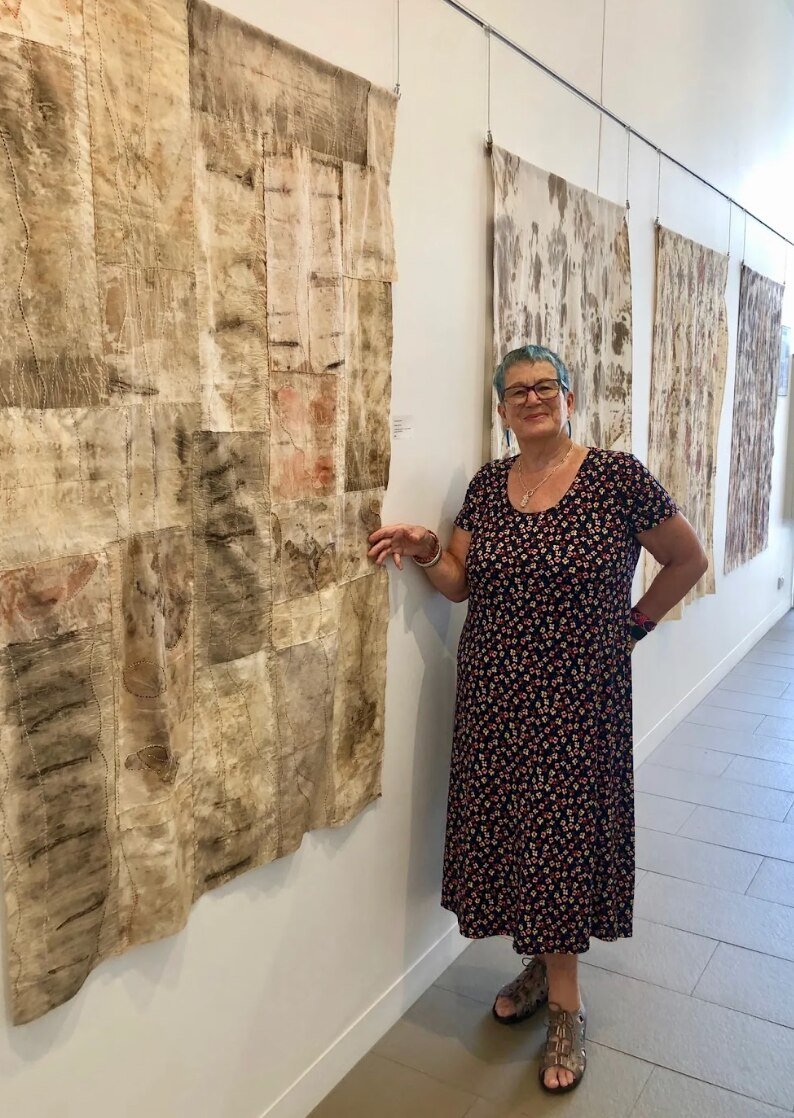ReCOVER continued
My exhibition ReCOVER at Gallery 76 Queen Street Sydney is done and dusted. My story was launched and it received positive feedback. It really looked lovely in that venue, one of the reasons I chose it. My artists statement plus detail images of all the pieces can be found on the RECOVER page on this website.
The opening was the first one at the Embroiderers Guild after the 'lockdown' and it was great to see so many interested persons viewing the three artists thats art was exhibited in the Galleries. ( as well as enjoying the wine and the delightful covid safe food treats.)
I will add some photos of the work in Gallery 4.
The following article about my exhibition was published th The Record, The EG monthly newsletter.
..........................................................
"Preceded by Australia’s longest drought, the 2019/20 fires were the culmination of the hottest and driest year on record. The inspiration for the work in the exhibition ReCover that Barbara Dawson held at Gallery 76 in March this year was the result of the experience of travelling through the fire ground after the fires and a subsequent visit the Morton National Park in March 2020 to photograph the regrowth of the eucalyptus in the aftermath of the fires.
Travelling along the Princess Highway from Melbourne that February after the fires Barbara noticed small signs of re-growth – tiny coloured sprouting leaves on the charred Eucalyptus trees - ecpicormic growth. As the months progressed the leaves further sprouted up the trunks and along the branches. This inspired a trio of work, Epicormic Growth I, II and III on recycled cloth.
Barbara uses a contact plant print process– a method of printmaking in which plant matter, a eucalyptus leaf, or leaf litter (Barbara always uses natives) is placed on a substrate – paper or fabric, a mordant is added, the paper or fabric is wrapped tightly and then simmered in eucalyptus leaves or steamed. Once it is taken out and dried the image of the plant matter is printed onto the substrate – hence a contact print.
In the Epicormic Growth series, Barbara used iron on the fabric to create the black marks that represent burnt trees. First, she placed Eucalyptus leaves on the cloth, then a series of nails. To get the little squiggly marks on the material, Barbara added bits of steel wool. The fabric was then bundled tightly and boiled in a pot of Eucalyptus leaves. Where you see a white background, the material has been so tightly rolled that it acts as a resist. The three pieces show the different stages of Epicormic growth that Barbara observed on her drive along the Princess Highway that summer. She has used seed stitch in varying colours to represent the different stages of new growth.
The photographs Barbara captured of the recovering bush at Tianjara Falls in the Morton National Park; inspired the series of large works on recycled sheets. Again, she used the contact print process that is found in her other works, laying down eucalyptus leaves on her background fabric, adding a mordant in the guise of a rusty water saturated paper towel, rolling it up tightly and then steaming. Once the large fabric pieces had dried, she took them back to the recovering fireground, hung them in the environment that had inspired them, then photographed and filmed them in situ. She then sat and drew what she was feeling or hearing. She drew the wind in the trees or the movement of the recovering leaves and plants. Drawing them not as an actual tree or the wind, but as the feelings that were generated by her observations. These mappings became the template from which to stitch onto the pieces that formed her ReCover series. The title is a play on words – her reactions to the recovery of the bush and her use of recycled bedcovers.
Barbara does not draw onto the fabric; rather she observes her drawing and then stitches from that observation. She calls this’ ‘inefficient stitching’. She has been asked how she knows where to stitch – and her response is that she has developed an understanding of composition, which she attributes to her art school training. When drawing she rarely draws realistic images, “If someone gave me a flower to draw I would start as normal but then I would expand and transform its inner or outer structure because if I want an exact image I take a photograph.”
Barbara’s artwork and process reflects the feelings that she experiences as she observes and immerses herself in the landscape. Each stage of her art process is an observation of what has gone before and a reaction to it.
Barbara will be exhibiting her artwork which will look at ‘weathering and degradation’ in Canberra this November and she will have another exhibition in Gallery76 in February 2023 based on the Littoral Landscape. "
Suganthi Singarayar
Barbara’s website: https://barbaradawson.com.au/
Barbara’s film: Textiles in the Landscape



